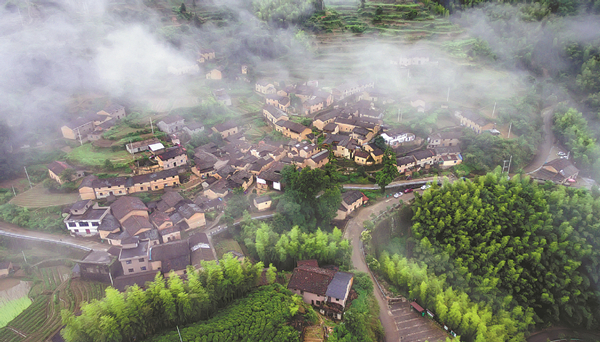Rediscovering their roots
Pingtian village highlights the pristine setting of Songyang county in Lishui, Zhejiang province. CHINA DAILY
Villages succeed at rural vitalization by tapping their rich heritage, which has prompted young residents to return from urban areas to help preserve and promote local culture
As a tea farmer, Jiang Xiaomei had worked in an enviable natural setting of misty mountains with crisp, clear air.
But cultivating the local specialty was tough. The leaves she picked from her 0.4-hectare plot helped her make about 12,000 yuan ($1,880) a year.
"It was very basic then. Things have improved significantly with the changes in the village. Income can be up to 40,000 yuan a year now," said Jiang, 49.
For the past two years, Jiang has been perfecting her skills at a workshop for traditional plant-based tie-dyeing. She also teaches the craft, which is listed as part of the local intangible cultural heritage, to urban visitors-up to 100 a day during peak travel periods.
"I've been dyeing our local fabrics since I was a child. It's good that I can help preserve and promote our heritage and make a good living from it," Jiang said.
Her experience reflects the impressive developments in Pingtian village of Songyang county in Lishui, Zhejiang province, in line with a national effort to close rural-urban gaps and improve livelihoods with the aim of common prosperity.
In August, a meeting of the Central Committee for Financial and Economic Affairs, which was chaired by President Xi Jinping, who is also general secretary of the Communist Party of China Central Committee, outlined steps to promote common prosperity through high-quality growth, calling for a phased approach to meet the goal.
With the drive for common prosperity expected to be comprehensive and long-term, the country is set to pursue it in a gradual and progressive manner, involving suitable areas that can offer replicable practices and models.
Zhejiang, one of the country's most developed provinces, has been designated a demonstration zone to forge a new path for inclusive growth.
The province aims to achieve common prosperity by 2035, with its per capita gross domestic product and the income and standard of living of urban and rural residents reaching those of developed countries.
As a key indicator of balanced development, Zhejiang's income ratio between urban and rural residents fell to 1.96:1 last year, significantly lower than the national level, according to provincial authorities.
Digitalization is set to become a major driver of growth in the province, empowering poverty reduction, public services and grassroots governance toward economic efficiency and social progress.


 Lishui establishes intelligent biodiversity monitoring system
Lishui establishes intelligent biodiversity monitoring system New fungus species discovered in Qingyuan
New fungus species discovered in Qingyuan Lishui transforms weirs to aid fish migration
Lishui transforms weirs to aid fish migration